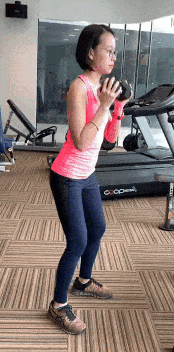3 Dumbbell Exercises for a Perkier Butt
Most of us dream of having a peachy bum and have the impression that it is hard to attain. However, our buttocks are actually made up of a group of gluteal muscles (one of the largest muscles in the lower body). Similar to other muscles in your body, these muscles require training in order to grow and become firm.
In this post, we are focusing on dumbbell exercises for the butt. You can also check out our post on home exercises for the whole body (Read: Home Workout Targeting All Your Major Muscles).
We know you wouldn’t want to read a lengthy post, so we have selected a few key points to make it short and sweet. Don’t worry, we have accompanying GIFs for each exercise. Okay, let’s get down to it!
1. SQUATS
DOs:
- Keep the spine long and straight throughout (video yourself to check!)
- Knees should point in the same direction as your feet
- Always think of moving from your hips
COMMON MISTAKES:
- Wobbling knees or shifting inwards
- One foot placed slightly in front of the other
- Moving from the knees before your hips
A very common yet effective way to work on your butt. We suggest Goblet Squats (holding a weight in front of you) as it is simple to set up and easy to execute with good form.
PROGRESSION: Pulsing Goblet Squats
“TIP: Squeeze your butt hard every time you stand up!”
2. DEADLIFTS
DOs:
- Keep the chest out to make the spine long and straight
- Slide dumbbells close to your legs
- Lower to a range where you feel your hamstrings (back thighs) being stretched
- Always think of swinging from your hips!
COMMON MISTAKES:
- Rounded back, which often happens when going down
- Using arms to carry the weights
- Hip drops so the distance between the hips and ground decreases (this becomes another deadlift form)
Different muscle groups are activated, which makes it one of the most efficient exercises. Our focus here is to build butt muscles so Stiff-Legged Deadlifts are recommended.
PROGRESSION: Single-Leg Deadlifts
“TIP: Being barefoot will help a lot in balancing!”
3. LUNGES
DOs:
- Keep the spine long and straight
- Place 90% weight on the front leg when lunging, the back leg is just for balance/support
- Knees should point in the same direction as your feet
COMMON MISTAKES:
- Upright torso with no slight forward lean (this reduces engagement of the butt muscles)
- Feeling the back leg work more than the front leg
- Wobbling knees or shifting inwards
During lunges, you are forced to isolate your butt muscles as you are supporting your body weight on one leg, while the other leg acts as a stabiliser. To engage the correct muscles and ensure that you have adequate stability, we start off with Stationary Lunges.
PROGRESSION: Walking Lunges with a Kickback
“TIP: Go down slowwww and controlled. THINK BUTT.”
For a start, you can do 15-20 reps of 4 sets for the above exercises with light weights. More resistance can be added by increasing the dumbbell weight gradually.
To ensure your workout routine is well-rounded, consider incorporating adjustable dumbbells into your regimen. These versatile weights allow you to easily switch between different weight options to match your strength level and the specific exercise you’re performing. Additionally, using a weight lifting belt can provide extra support during heavy lifts, promoting better form and reducing the risk of injury. Remember, consistency in your dumbbell workout is key to achieving the best results for your butt muscles.
You may find yourself getting stuck without any improvements after a while (this is normal) so minor tweaks can be implemented into your fitness program. Our team of personal trainers is here to help you plan your exercise program so you will not hit a plateau. They are located in boutique gyms island-wide and can travel to your home for personal training as well. Book a free consultation with us below!







